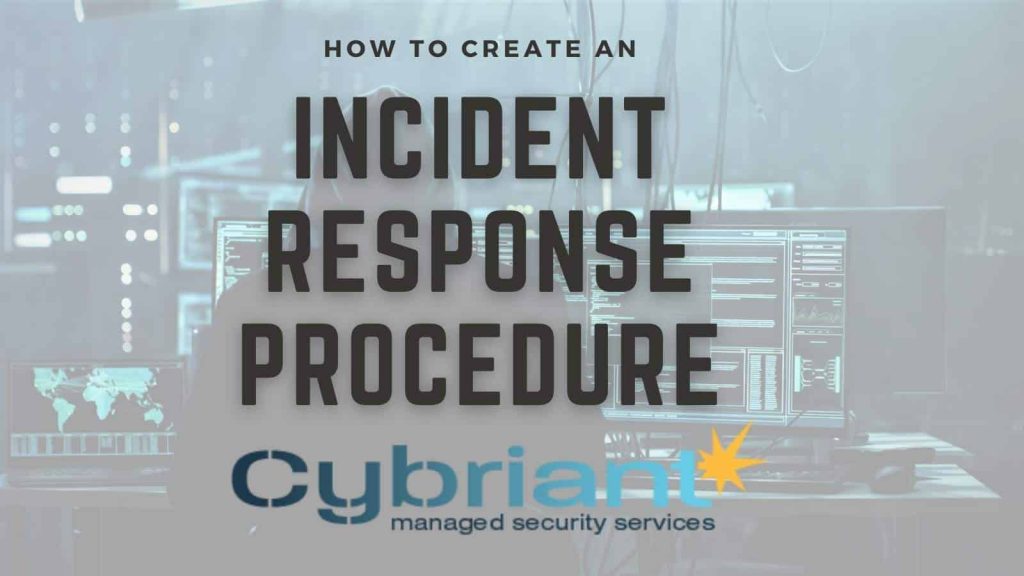In the event of a data breach or security incident, having a well-defined incident response procedure can help contain the damage and minimize the risk of future incidents.
When it comes to handling a security incident, having a plan in place can help mitigate damage and minimize the impact on your organization.

Stages of Incident Response
The stages of the incident response process typically include preparation, identification, containment, eradication, recovery, and debriefing/lessons learned.
Incident Management Process Steps include:
- Preparation involves establishing a team and determining roles and responsibilities ahead of time.
- Identification involves discovering and confirming that an incident has occurred.
- Containment involves reducing the spread of the incident, while eradication involves removing the source of the incident.
- Recovery includes restoring systems and ensuring normal operations can resume, and debriefing/lessons learned involves analyzing what went well and what could have been improved upon during the incident handling process.
As part of these stages, regular communication with appropriate parties (e.g., executives, and customers) is important to maintain transparency and trust throughout the entire incident response process. By following a structured approach to dealing with security incidents, organizations can reduce their overall risk exposure.
In other words, having an incident response plan in place is mission-critical for any organization serious about protecting its data and infrastructure.

Incident Response Procedure
An incident response or incident management procedure outlines the steps that need to be taken in the event of an incident, who is responsible for each step, and how to contact the appropriate personnel.
Creating an incident response procedure may seem like a daunting task, but it doesn’t have to be. By following these simple steps, you can create a procedure that will help your organization respond quickly and effectively in the event of an incident.
Define What Constitutes an Incident
The first step in creating an incident response procedure is to define what constitutes an incident. This will help ensure that everyone is on the same page and knows when to activate the procedure. For example, you may want to consider any event that results in unauthorized access to confidential data or systems, or any event that could potentially lead to data loss or system downtime as an incident.
Assemble a Cross-Functional Team
Once you’ve defined what constitutes an incident, the next step is to assemble a cross-functional team that will be responsible for responding to incidents. The team should include representatives from different departments within the organization, such as IT, Legal, and Human Resources. Having a diverse team will help ensure that all bases are covered during an incident and that no stone is left unturned.
Identify Key Stakeholders and Their Roles
Another important step in creating an effective incident response procedure is to identify key stakeholders and their roles. This includes identifying who needs to be contacted in the event of an incident, as well as their respective roles and responsibilities. For example, the team leader may be responsible for contacting external parties such as law enforcement or insurance companies, while the head of IT may be responsible for leading efforts to contain and resolve the technical aspects of the incident.
Develop Standard Operating Procedures
Now that you’ve assembled your team and defined everyone’s roles and responsibilities, it’s time to start developing standard operating procedures (SOPs) for responding to incidents. SOPs should outline the steps that need to be taken to minimize damage and contain the incident. They should also include timelines for each step so that everyone knows expectations and deadlines.
Test Your Procedure Regularly
It’s important to test your incident response procedure regularly so that you can identify any weaknesses or gaps in coverage. Testing can be done through simulations or tabletop exercises where different scenarios are played out and possible responses are evaluated. By regularly testing your procedure, you can make sure that it is up-to-date and effective when an actual incident occurs.

Incident Response Team
In addition to having an incident response plan, it’s imperative to have an incident response team in place. The team should be composed of individuals from different departments within the organization so that all bases are covered during an incident. The team should also have a clear understanding of their roles and responsibilities, as well as the steps that need to be taken in order to effectively respond to an incident. Your incident response team members should include:
Leadership
The incident response team should have a leader who is responsible for coordinating the team’s efforts and ensuring that everyone is on the same page. The leader should also be responsible for contacting external parties such as law enforcement or insurance companies, if necessary.
Technical Expertise
The incident response team should also have a member with technical expertise who can lead efforts to contain and resolve the technical aspects of the incident. This may include restoring systems or data, as well as identifying and addressing any security vulnerabilities that may have led to the incident in the first place.
Communications
Communication is another important aspect of an effective incident response team. The team should have a designated communication person who is responsible for keeping everyone informed of the latest developments and ensuring that information is disseminated in a timely and accurate manner.
Legal Counsel
The team should also have legal counsel who can advise on any legal issues that may arise during an incident. This may include dealing with data breaches, intellectual property theft, or cybercrime.
Human Resources
Lastly, the team should have someone from human resources who can assist with any employee-related issues that may come up during an incident. This may include providing counseling services or assisting with workplace safety procedures.
By having an incident response team in place, you can be sure that all bases are covered and that no stone is left unturned during an incident. By having a clear understanding of roles and responsibilities, as well as a well-tested plan of action, you can minimize damage and contain the incident so that business can resume as usual.
The incident response team should have a clear understanding of their roles and responsibilities, as well as the steps that need to be taken in order to effectively respond to an incident.
The team should also have a designated leader who is responsible for coordinating the team’s efforts and ensuring that everyone is on the same page.
Furthermore, the team should have someone with technical expertise who can lead efforts to contain and resolve the technical aspects of the incident.
Lastly, the team should have a designated communications person who is responsible for keeping everyone informed of the latest developments.
By having an incident response team in place, you can be sure that all bases are covered and that no stone is left unturned during an incident.

NIST Incident Response Framework
The NIST incident response framework and NIST incident response methodology provides a structured approach for responding to incidents. It is composed of four main phases:
Preparation
The first phase of the NIST incident response framework is preparation. In this phase, organizations should establish an incident response team and plan, as well as identify the resources that will be needed during an incident. This phase should also include training for the incident response team so that they are prepared to effectively respond to an incident.
Detection and Analysis
The second phase of the NIST incident response framework is detection and analysis. In this phase, the incident response team will identify and assess the scope of the incident. They will also gather information about the incident so that they can better understand what happened and how to resolve it.
Containment, Eradication, and Recovery
The third phase of the NIST incident response framework is containment, eradication, and recovery. In this phase, the incident response team will take steps to contain the incident and prevent it from spreading. They will also work to eradicate the root cause of the incident and restore systems and data. Lastly, they will put in place measures to prevent similar incidents from occurring in the future.
Post-Incident Activity
The fourth and final phase of the NIST incident response framework is post-incident activity. In this phase, the incident response team will debrief and document the incident. They will also review their performance and make any necessary changes to their procedures. Lastly, they will conduct a lessons-learned exercise to ensure that they are prepared to effectively respond to future incidents.
By following the NIST incident response framework, organizations can be sure that they are taking the necessary steps to effectively respond to an incident. This framework provides a structured approach that can be followed in order to minimize damage and contain the incident so that business can resume as usual.
Eradication in Cybersecurity
Eradication in cybersecurity involves creating a detailed plan to eliminate vulnerabilities and secure a system from potential attacks. This effort usually includes creating firewalls, updating software and hardware, implementing encryption, and training personnel on proper security measures. It also might involve patching systems and eliminating any malware or viruses through scanning tools.
In many cases, it is important to have a dedicated team that is constantly monitoring the system and responding quickly to any potential threats. Additionally, it is essential to monitor user activity and maintain proper access control measures. These steps can help make sure that the system remains secure against malicious actors. Finally, having an incident response plan in place can also help minimize the damage caused by any cyber-attacks. By taking these steps, organizations can ensure that their system remains secure and any threats are quickly identified and addressed. Eradication in cybersecurity is an ongoing process and requires vigilance to maintain.
To keep up with the ever-evolving cyber threat landscape, organizations must remain proactive in their security efforts. This means regularly updating software and hardware, monitoring user activity, and responding quickly to any potential threats. Doing so not only helps protect the organization from cyber-attacks but can also help reduce the risk of data breaches or other security incidents.
SOC Incident Management Process
The SOC (Security Operations Center) incident management process is a crucial component of an organization’s security strategy. It helps the SOC team to quickly detect, respond to, and recover from security incidents that could harm the organization’s systems, data, and reputation.
The typical SOC incident management process consists of several phases, including:
- Incident Detection: The first step is to detect and classify the incident. This may involve identifying unusual activity patterns or security alerts triggered by security tools, such as intrusion detection systems (IDS) and security information and event management (SIEM) systems.
- Incident Triage: Once an incident has been detected and classified, the SOC team conducts a triage process to determine the scope, severity, and impact of the incident. This helps prioritize the response efforts based on the risk to the organization.
- Incident Containment: The next step is to contain the incident by isolating affected systems or networks to prevent further damage. This may involve shutting down affected systems or disabling network connections.
- Incident Investigation: At this stage, the SOC team conducts a thorough investigation to identify the root cause of the incident, the extent of the damage, and any potential indicators of compromise (IOCs) that may suggest a breach.
- Incident Mitigation: Once the investigation is complete, the SOC team implements a mitigation plan to minimize the impact of the incident. This typically involves removing malware, restoring backup data, and patching vulnerabilities.
- Incident Reporting: Finally, the SOC team documents the incident, outlining the details of the incident, the response efforts, and any lessons learned. This helps to inform future incident management processes and improve the organization’s security posture.
Overall, the SOC incident management process is a critical component of any cybersecurity strategy, helping organizations to quickly respond to security incidents and prevent further damage.
7 phases of incident response
Incident response is an important part of any security posture. It helps to ensure your organization can respond quickly and effectively to cybersecurity incidents, minimize disruption and related costs, and ensure regulatory compliance. The National Institute of Standards & Technology (NIST) has identified seven phases in the incident response lifecycle – Preparation, Identification, Containment, Eradication, Recovery, Lessons Learned, and Post-Incident Activity.
- Preparation – Planning for incident response involves developing an incident response plan that outlines workflows, roles and responsibilities, communication protocols, tools to be used and other elements of the process. It is important to identify the resources needed in advance so that they can be engaged quickly if a security incident occurs.
- Identification – This phase involves detecting the incident, classifying it based on severity and determining its scope. Security teams should prioritize their efforts and focus first on incidents that present the most significant risks to the organization.
- Containment – In this step, organizations attempt to stop the spread of an incident and prevent further damage from occurring. Depending on the type of incident, this may involve disconnecting systems from the network, reconfiguring firewall rules or using other methods to contain it.
- Eradication – In this phase, organizations identify and remove malicious code or other threats that were responsible for an incident. This includes implementing patches and software updates to address vulnerabilities that allowed attackers to gain access in the first place.
- Recovery – The goal of this phase is to return the impacted systems and applications to a normal, functioning state. This may involve restoring data from backups and rebuilding configurations that were affected by the incident.
- Lessons Learned – In this step, organizations should analyze what happened during the incident response process and use the information to update their response plans. This includes identifying areas in which they need to improve and developing additional controls that can help prevent similar incidents from occurring in the future.
- Post-Incident Activities – After an incident, organizations should monitor for any related activity and follow up with affected stakeholders. They should also use this opportunity to review their processes and policies and ensure that they are prepared for similar situations in the future.
In order to have an effective incident response plan, organizations should start by assessing their security posture and identifying areas of vulnerability. This includes evaluating the current state of their IT infrastructure, analyzing log data for suspicious activity, and scanning external facing systems for potential exploits.
Incident Response Workflow
Organizations should have an established incident response workflow in place to ensure that they can effectively respond to incidents. This includes outlining the specific steps that need to be taken during each phase of the response process, as well as assigning roles and responsibilities for each team member involved.
The steps in a typical incident response workflow include:
- Preparation – This step involves defining the roles and responsibilities of each team member, as well as developing an incident response plan. Organizations should also identify and train personnel who will be needed in the event of a cyber incident.
- Identification – During this phase, organizations should analyze log data and other indicators to determine whether or not an incident has occurred. If an incident is identified, organizations should document the details and begin to gather evidence.
- Containment – Organizations should then take steps to contain the incident and prevent it from spreading or causing further damage. This could involve taking systems offline, disabling user accounts, or other measures.
- Eradication – During this phase, organizations should take action to remove any malicious code or compromise and restore the affected system to its original state.
- Recovery – In this step, organizations should work to recover any data that has been lost, as well as begin restoring operations to normal.
- Post-Incident Activities – Organizations should take steps to review their incident response plans and procedures, update security controls where needed, and document the incident.
Having an effective security posture is essential for organizations to ensure that they are prepared in case of a cyber incident. Establishing an incident response workflow and developing procedures that outline the steps to be taken during each phase can help ensure that organizations are able to quickly and effectively respond to any incidents that occur. It is also important to train personnel and review security controls regularly to ensure that any gaps in security can be identified and mitigated. By taking these steps, organizations can more effectively protect their systems from cyber threats.
It is also important for organizations to create an incident response playbook that outlines the roles and responsibilities of each team member as well as the steps that should be taken during each phase of the incident response workflow. Having a clear understanding of what needs to be done can help organizations respond more quickly and efficiently during an incident, resulting in fewer impacts on operations. Additionally, developing plans for how different types of incidents should be handled can also help ensure that teams are better prepared when responding to an incident.
CMMC Incident Response Plan
As the first line of defense against cyber security incidents, organizations must have a comprehensive incident response plan in place. The Cybersecurity Maturity Model Certification (CMMC) Incident Response Plan provides a clear and concise framework for organizations to respond quickly and effectively to any event that compromises their security posture.
The CMMC Incident Response Plan outlines an escalation process that should be implemented to effectively manage a response to an incident. The plan details the steps for gathering evidence, assessing and addressing the implications of the event, determining appropriate corrective actions, and communicating internally as well as externally about the incident.
The CMMC Incident Response Plan also provides detailed guidance on how organizations can develop their own incident response plans, as well as how to implement these plans in a timely manner. The plan includes instructions on establishing incident response teams, assigning roles and responsibilities, and documenting the steps taken during incident response.
Conclusion
An effective incident response procedure is essential for any organization; it helps minimize damage, contains incidents, and ensures that everyone knows their roles and responsibilities in the event of an emergency situation. By following these simple incident response processes, you can create a procedure that will help your organization respond quickly and effectively if an incident does occur.



